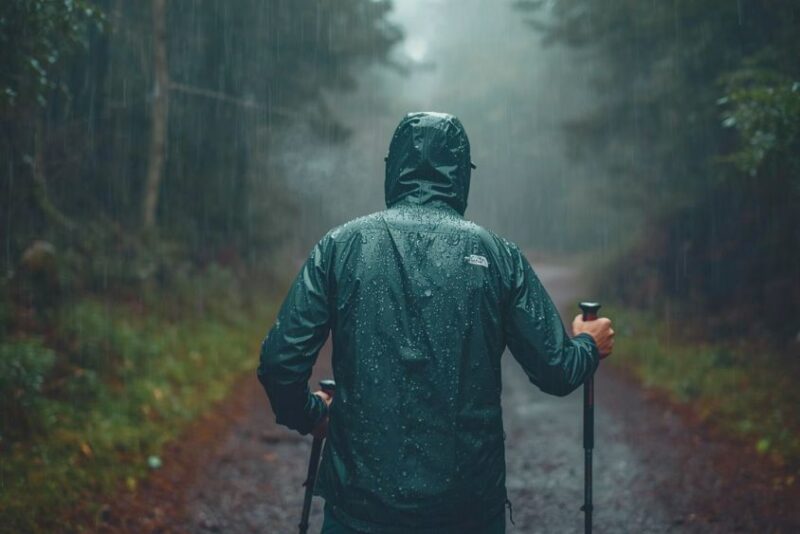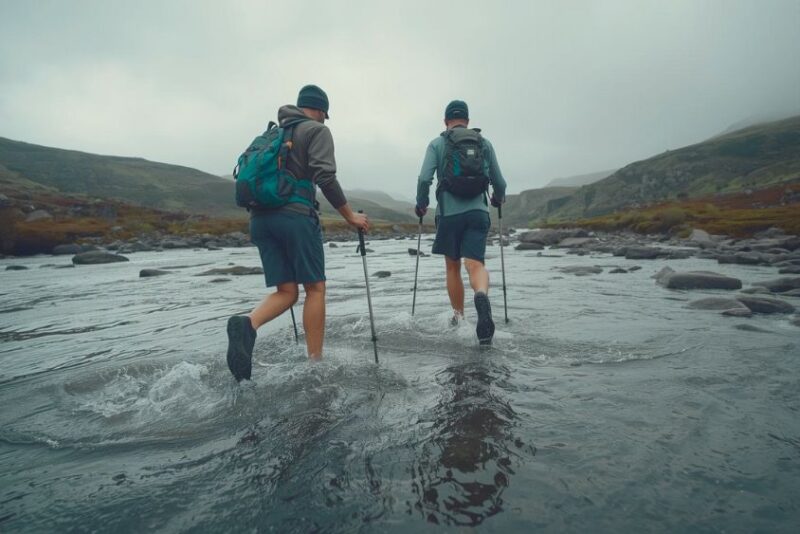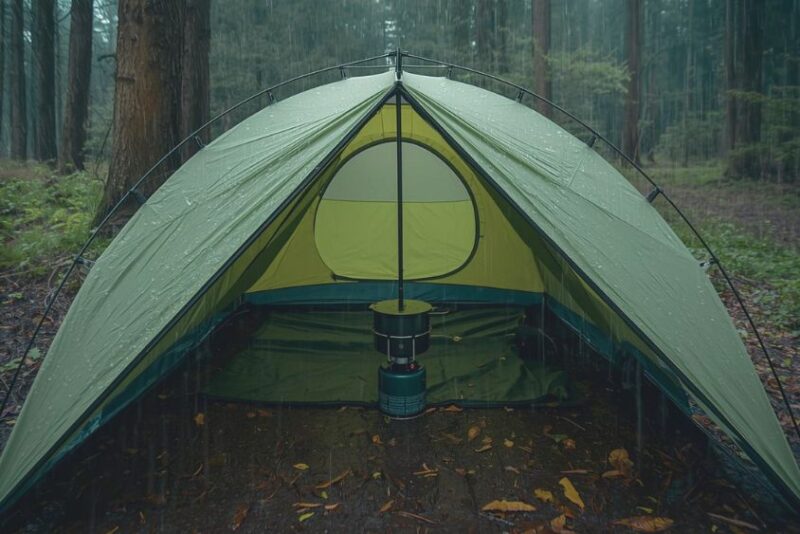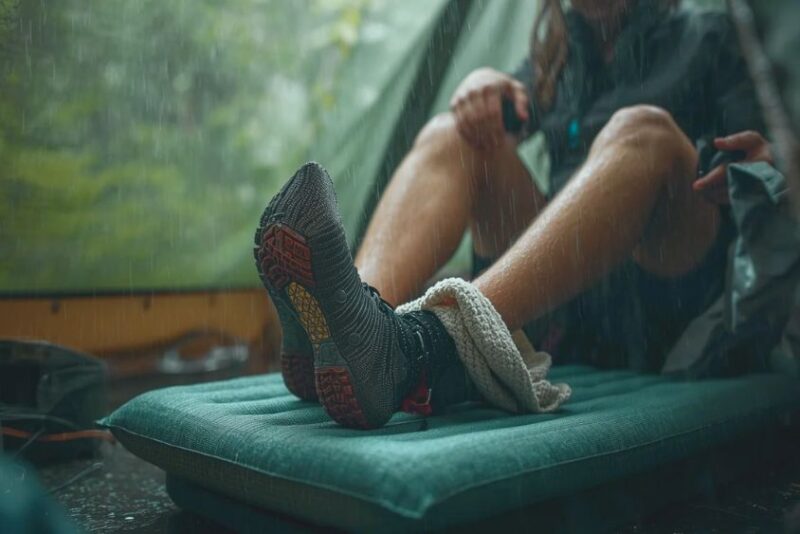Rain doesn’t have to cancel the adventure—backpacking in the rain can actually make the forest smell brighter, the crowds thinner, and your skills sharper. Imagine this: you’re five minutes from the trailhead when the sky flips a switch.
Panic? Nah. With the right moves, you’ll vent heat, seal the critical gear, and glide past puddles like you meant to do this all along.
I’ll keep it nerdy-but-friendly and strictly practical—no sales pitches, just field-tested sense. Ready to trade soggy misery for calm control? Good—let’s start with your 60-second rainy-day game plan
When the Sky Opens: Your 60-Second Rain Plan

Pause, breathe, then do these in order:
- Dump heat first. Crack pit-zips, loosen the hem, snug the hood, and ease your pace. The goal is to stop sweating through your base layer before it becomes a personal steam sauna.
- Seal the non-negotiables. Confirm your pack liner is rolled tight (think: trash-compactor bag or dedicated liner). Keep the sleep system and puffy in separate dry bags; map/phone double-bagged.
- Switch to “traction mode.” Shorten your stride, place your feet flat, and use trekking poles for three points of contact. Treat wet roots and boardwalks like ice.
- Micro-adjust layers, not heroics. If you’re clammy, swap a mid-layer the moment you’re under cover. Small tweaks beat slogging yourself wet from the inside.
- Edit the route. Favor high ground over gullies, avoid new stream crossings, and trim objectives if water is rising or wind is pushing you around.
- Fuel on a timer. Cold rain hides thirst and hunger. Snack small and often; sip even when you don’t feel like it.
- Go/No-Go check. Thunder close, water moving fast above knee depth, or trees swaying hard? Downshift the plan or call it. Smart beats stubborn.
Safety First: Lightning And Fast Water
Lightning (read this before the sky rumbles)
If you can hear thunder, you’re already in range. Follow the lightning safety rules: get to a substantial building or fully enclosed vehicle, and don’t head back out until 30 minutes after the last thunder.
A quick distance check: see a flash, count the seconds to thunder, divide by 5 to get miles (10 seconds ≈ 2 miles). Skip the “hero under a tree” move—no place outside is truly safe during a thunderstorm. (NOAA)
Do this:
- Drop off ridgelines and away from isolated tall trees/towers.
- Spread your group out (10–15 m) to reduce multiple casualties.
- Stow metal trekking poles; they’re not lightning magnets, but you don’t want tall pointy things in your hands.
Rivers & Streams (more hikers get humbled by water than lightning)
Treat moving water with the respect you’d give traffic. Pick the widest, shallowest spot with the slowest current; avoid blind bends and frothy chutes. As a simple rule of thumb, avoid crossing water deeper than your knees.
Unbuckle your hip belt and sternum strap, face slightly upstream, and use trekking poles for a three-point stance. If the push on your shins feels sketchy, it is—turn back or find another spot. Morning is often calmer than late in the day. For a deeper dive, learn the steps for safe river crossings.
Storm Sense: Safety That Actually Saves You

Unstable slopes (rain moves mountains)
Heavy rain lubricates soil layers and adds weight to loose hillsides. Red flags: fresh cracks in the tread, tilted trees, bulging soil, water sheeting across the trail, or a gully that suddenly sounds like a freight train.
Your play: avoid cutbanks and run-out zones, don’t loiter below cliffs, and favor forested ridges over gullies. If the slope feels sketchy, backtrack—gravity doesn’t negotiate.
Hypothermia in “not-that-cold” rain
Warm air + wind + wet clothes can drop your core fast. Early signs look small: clumsy fingers, mumbled words, stumbles on easy ground. Act immediately—vent first, then swap to a dry layer, add a windproof shell, eat quick carbs, and move steadily.
If shivering goes from “helpful” to “gone,” stop, shelter, insulate (sleeping bag/puffy), and make a conservative exit plan.
Carbon monoxide (CO): the invisible storm risk
Rain tempts people to cook in tents. Don’t. CO is colorless, odorless, and disabling before it’s obvious. Build a tarp “porch” or cook fully outside, downwind, with max ventilation.
Keep flames off the tent floor, never inside a vestibule with doors zipped, and shut stoves down if you feel a headache, dizziness, or nausea. Gear can dry later—lungs are now.
Wear The Weather: Layering That Works In Real Rain
You don’t beat rain by armoring up—you win by managing sweat better than the storm.
- Base layer (next-to-skin): Go synthetic or merino. Fit should be close but not vacuum-tight. If you’re already damp, swap fast under cover; a 90-second change can save a whole day.
- Mid-layer (active warmth): Think breathable fleece or a light synthetic puffy you’re not precious about. Keep one dry emergency layer quarantined in a dry bag for camp only.
- Shell (your pressure valve, not a sauna): Favor a well-cut rain jacket with a stiffened brimmed hood, hem/cuff adjusters, and real venting (pit-zips or 2-way front zip). 3-layer shells typically handle all-day storms better than 2.5-layer; either way, vent early and often.
- Legs: Full-zip or ¾-zip rain pants make on/off easy around muddy boots. If you run hot, a rain kilt/skirt plus warm tights can be a legit combo in shoulder seasons.
- Hands & head: Thin liner gloves under waterproof shells = dexterity plus warmth. A cap under the hood keeps rain off glasses and stops the “drip down the nose” effect.
- Feet (the truthy bit): Waterproof boots shine on cold, sustained rain; drain-fast trail shoes can be better in warm, dumping rain where everything gets wet anyway. Prioritize tread that bites on slick roots and rock. Gaiters help keep splash-in down.
- Insulation choice in the wet: If you’re debating puffies, see our plain-English breakdown: Down vs Synthetic Jacket. If you want a deeper dive for later, bookmark our neutral roundup of field-proven options: best down jackets. (No shopping here—just context.)
Pro tip: Treat “open your vents” as a reflex, not a last resort. Most “rain misery” is really “overheated in waterproofs.”
Dry On The Inside: Pack And Camp Systems That Don’t Fail

Rain wins when water sneaks into your sleep kit or insulation. Your job is simple: make those items untouchable.
Pack-dry hierarchy (don’t skip steps)
- Liner first. Use a trash-compactor bag (or dedicated liner) inside your pack. Roll it like a dry bag.
- Criticals double-protected. Sleep system and puffy each in their own dry bag. First-aid, fire, and comms get zip-top redundancy.
- Covers are secondary. Pack covers help with runoff, but wind pushes rain sideways—never rely on a cover alone.
- Wet stash lives outside. Dedicate one outer pocket for soggy gear so the dry zone stays sacred.
Pitching in rain (fly-first, less drama)
- Site reads: Slightly convex ground (water sheds away), not a bowl. Doors leeward. Avoid run-out zones and depressions.
- Footprint sizing: The Groundsheet should be a little smaller than your tent floor so water can’t collect between layers.
- Fly-first rig: Pre-tie guyline loops at home; in the field, toss the fly over, stake corners, add two windward guys, then clip in the inner.
- Porch mode: Trekking poles at the doorway for a sheltered workspace to cook outside and swap layers without soaking the interior.
- Tension + re-tension: Nylon sags when wet. Re-tighten guys 10–15 minutes after setup and again before bed.
Condensation control (the hidden soak)
Crack opposing vents/doors, keep damp gear out of the sleeping area, and avoid brushing the fly with your bag. If wind shifts, reorient the door downwind to keep mist out while you ventilate.
LNT when it’s sloppy
Stay single file in the middle of muddy tread (skirting widens the trail), and keep camp 200 feet from water. Brush up on Leave No Trace durable surfaces before you go—small choices matter most in wet conditions.
Sleep-dry protocol (so tomorrow doesn’t start miserably)
- Quarantine the dry kit. One base layer + socks is for sleep only.
- Boots: Pull insoles, shake water, and air under the porch. If it’s cold, place warm (not hot) rocks wrapped in a bandana inside for 10–15 minutes; never use open flame.
- Clothes: Wring hard, pat with a microfiber, then hang in maximum airflow (under the porch or inside on a line away from your bag).
- Comfort bump: If nights run chilly, a compact layer from our best travel blankets can add warmth without risking your dry bag hierarchy.
Nerd note: Most “mysterious leaks” are either condensation brushed by a sleeping bag or water wicking off a too-large footprint. Fix those first.
After The Deluge: Water, Food, And Power That Don’t Quit
Water you actually trust. Storms stir up silt and critters. If bottled water isn’t an option, boil for 1 full minute (longer at high elevation). If boiling isn’t possible, settle and pre-filter cloudy water through a clean cloth, then disinfect per public-health guidance. For clear, memorable instructions, bookmark make water safe in an emergency (boil beats chemicals for many parasites). [CDC]
Kitchen that doesn’t gas you out. Cook outside, under a tarp “porch,” with max airflow. Stable stove, low flame, clear of tent fabric. If the wind howls, cold food > risky setup. (Remember our CO rule from Safety First: tents and zipped vestibules are a hard no.)
Food that fights the shivers. Rain hides thirst and hunger. Snack small + often: quick carbs with a little fat/salt (think dates + nuts, tortillas + peanut butter). Set a 30–45-minute timer; future-you will thank you.
Electronics that live to tell the tale. Double-bag your phone/PLB in nested zip-tops or a dry pouch; keep power banks in their own dry bag. Cable discipline: one labeled, short cable in a tiny zip-top so you’re not rummaging in the drizzle.
Power strategy in the wet. Top up at lunch while you’re dry under the porch. If you carry a panel, charge the bank first, then devices from the bank—simpler, fewer wet-cable moments.
Feet Vs. Water: Outwalk Maceration

Your goal isn’t “dry feet 24/7”—it’s healthy skin and stable traction so you can keep moving tomorrow.
1) Run a sock rotation (the anti-maceration trick).
Carry 2–3 pairs of merino or synthetic socks. Hike in Pair A, swap to Pair B at lunch, air A on your pack. Sleep in a sacred dry pair you never hike in. In the morning, hike in the least-damp pair; keep the dry ones for night only.
2) Lube or powder—pick a lane and be consistent.
If you blister from friction, use a thin film of anti-chafe balm on heels/toes before you start. If your skin gets soggy, use a light dusting of foot powder at the lunch swap. Don’t stack both at once (they cancel each other out).
3) Manage water, don’t fight it.
In warm, dumping rain, drain-fast trail shoes with good tread can beat “waterproof” boots that eventually wet out. In cold rain or snowmelt slop, waterproof boots + short gaiters reduce splash-in and keep debris out.
4) Micromoves that matter.
- Heel-lock lacing (runner’s loop) to stop in-shoe slide on slick descents.
- Toenails trimmed straight across; a tiny overhang becomes a big toe bang when it’s wet.
- Insoles out at camp; stand them in airflow under the porch.
- Elevate + air break: shoes off 5–10 minutes at lunch; feet up on a sit pad.
5) Early warning signs (treat before they shout).
- Maceration: pale, wrinkled, rubbery skin. Response: powder, air break, rotate socks, reduce standing water inside the shoe (re-tie, adjust gaiters).
- Hot spots: tingling or burning on heels/toes. Response: dry the area, apply tape or blister pad now, not “later.”
- Cold numbness: add a thin liner sock, eat quick carbs, move—circulation is warmth.
6) Overnight recoveries.
Pat socks in a microfiber towel, then hang in max airflow. If it’s chilly, slip sleep-only socks on, elevate feet in the bag for 10 minutes, and call it a win. Tomorrow you’ll thank tonight-you.
Tropical And Monsoon Playbook: Timing, Terrain, Sanity
- Start early, finish early. Convective storms build after lunch; be off exposed ridges and out of narrow gullies by mid-afternoon.
- Read the ground. Fresh sediment fans, water “sheeting,” a gully roaring? Detour to higher, broader terrain—even if it adds distance.
- Flash-flood habits. Avoid slotty canyons, narrow bridges with no upstream visibility, and undercut riverbanks. If it’s hammering upstream, treat “dry” beds as not dry.
- Humidity management. Fast-dry layers, frequent air breaks, and a sleep-only base layer sealed in its own dry bag.
- Leech & critter plan. Light gaiters + long, quick-dry socks; quick checks at breaks; peel leeches off with a fingernail swipe (no salt or flame).
- Monsoon kitchen. Pitch the tarp first, cook well outside the tent body, keep flame low/stable. If wind overwhelms your porch, cold food beats risky cooking.
Care And Feeding of Rain Gear (PFAS-Free, Reality Check)
Clean gear sheds water better—that’s physics, not marketing.
- Wash the shell. Dirt/body oils make fabric “wet out.” Use a tech-wash (or mild liquid soap sparingly), cold water, gentle cycle, extra rinse. Air-dry till damp, then low tumble to help re-activate DWR. Re-proof more often in humid climates.
- Restore the DWR (PFAS-free). Modern finishes are PFAS-free (good!) but need more frequent touch-ups. Spray-on for jackets (shoulders/hoods), wash-in for pants. Warmth helps set it—follow the label.
- Seams & zips. Inspect taping; spot-seal pinholes on shelters and seam lines before the next trip. Lightly lube zippers.
- Down got soaked? Handle gently, avoid wringing, re-loft with patient drying. At home, see how to wash a down jacket for step-by-step care without killing the loft.
- Storage rules. Bone-dry before the closet. Hang shells (don’t crush). Store sleeping bags uncompressed.
Happy backpacking!
FAQs
Is an umbrella worth carrying in the wind?
In light wind, it’s glorious ventilation; in gusts, it’s a sail. If you bring one, pair it with a brimmed cap and keep your other hand free for poles/balance.
Is 10k/10k “waterproof enough” for all-day rain?
Often yes—if you manage sweat (vent early, pace down). For wind-driven storms, fit/venting matters more than chasing bigger numbers.
When should I turn back at a stream crossing?
Above knees, pushy on shins, or ugly run-out? Call it. Wait for levels to drop, seek a wider spot, or reroute. Pride is not a flotation device. (Revisit the safe river crossings guidance once, then commit it to memory.)
How do I dry soaked boots overnight without a fire?
Insoles out, pat with a microfiber towel, loosen laces wide, and air under the porch. In cold weather, use warm (not hot) wrapped rocks for 10–15 minutes—never open flame.
Is cooking in a vestibule ever safe?
No. Treat vestibules and zipped tent doors as indoor spaces—use a tarp porch with real airflow instead to avoid carbon monoxide buildup.
